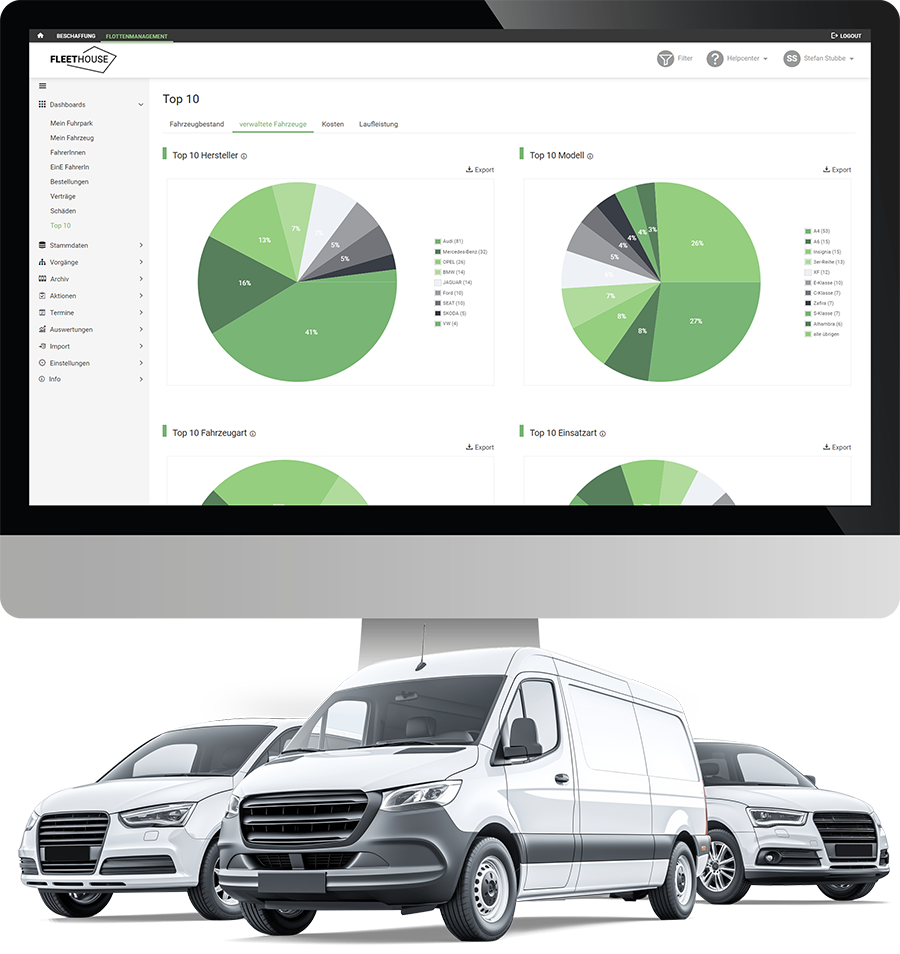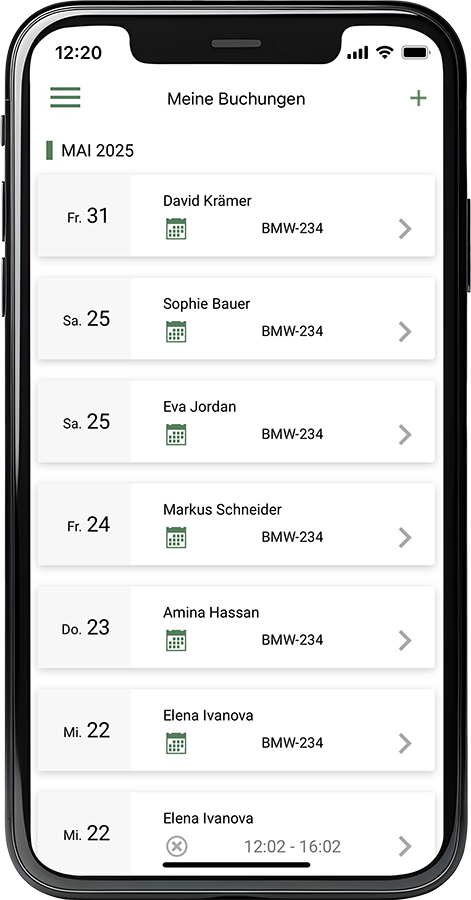The term car sharing is widely used. Especially in large cities and metropolitan areas, car sharing has already established itself among private individuals. And car sharing is also becoming increasingly interesting for companies in a corporate context. In our article, we explain what corporate car sharing is, who this mobility alternative is suitable for and how software can help you implement it successfully.
Contents
What is corporate car sharing?
In contrast to the classic company car model in the vehicle fleet, where each employee is assigned a company car, with corporate car sharing the vehicles are shared. Drivers can book the pool vehicles as required. In some companies, private use of the vehicles is also permitted, which must be taken into account when taxing the non-cash benefit.
Companies do not have to choose between the classic company car model and corporate car sharing. Both mobility concepts can be combined to meet the individual requirements of the vehicle fleet and the needs of the employees. In addition, other alternatives to support corporate mobility can also be integrated as part of corporate car sharing. These include, for example, the sharing of company bikes or electric cars.
Advantages of corporate car sharing for companies
Sharing vehicles brings a number of financial and environmental benefits for the vehicle fleet. Purchasing a separate company car for each employee often requires a lot of resources, which can have an impact on the company’s costs and sustainability . The use of pool vehicles can help here and offers a number of advantages:
- Cost savings through optimized vehicle usage: By sharing the fleet, the utilization per vehicle can be increased and fleet managers have to purchase fewer vehicles. This can save considerable costs in terms of acquisition, maintenance, insurance and vehicle tax. After all, unused vehicles also cause unnecessary expenditure.
- Increased sustainability and environmental friendliness: The production of new vehicles is resource-intensive. However, if fewer vehicles are required in the fleet through corporate car sharing, this is more sustainable and environmentally friendly than providing every employee with a vehicle. In addition, electric vehicles are particularly easy to integrate into a car sharing concept, which can further minimize CO2 emissions in the fleet.
- Flexibility and improved availability: employees can reserve a vehicle quickly and easily via booking systems. This means that vehicles are always available when needed, without each team member needing their own car. This ensures more efficient use and better accessibility to customer appointments and locations. In addition, vehicles with special equipment can be used flexibly depending on the occasion.
- Reduced administrative workload: The fewer vehicles there are in the fleet, the less maintenance is required. Automated processes in vehicle management also eliminate time-consuming organizational tasks such as manual bookings, billing or maintenance planning. Modern car sharing systems perform these tasks digitally. This allows fleet managers to concentrate on strategic tasks.
- Increased employee satisfaction: Easy access to company vehicles improves employees’ mobility and makes their daily work easier. Flexible usage models, including the private use of car-sharing vehicles, increase the company’s attractiveness as an employer. In addition, a sustainable and modern vehicle fleet contributes to a positive corporate culture.

Complete package for your corporate car sharing
Fleethouse offers all functions for smooth car sharing for companies: from booking to owner liability to return.
Digital support from a car sharing software provider
To ensure that car sharing works smoothly for companies, it is advisable to use a software solution for fleet management and corporate car sharing. Organizing with the email provider’s calendar tool may initially appear to be a cost-effective and simple solution, but in the long run fleet managers will reach their limits.
A car sharing software provider such as Fleethouse makes it easier to manage and book the pool vehicles, ensures transparency in the fleet and helps to manage the fleet efficiently.
The advantages of corporate car sharing software:
- Simple booking via app: Employees can book vehicles independently and around the clock using the web application or smartphone app. This saves time, as no manual coordination by fleet management is required. The intuitive operation simplifies the booking process and increases flexibility for users.
- Clear booking calendar: In the central booking calendar, all employees can see at a glance when vehicles are available and can plan their journeys accordingly.
- Automatic notifications: The software automatically informs drivers about changes to their booking, be it due to delays, rebookings or cancelations. This ensures better planning and prevents misunderstandings.
- Reporting: Detailed reports and analyses enable the company to monitor vehicle usage and identify optimization potential. As a result, capacity utilization, vehicle requirements and costs can be continuously improved.
- Compliance with owner liability obligations: With car sharing software, driving license checks, maintenance intervals or safety checks can be digitally recorded and documented. This enables fleet managers to safely fulfill their owner liability obligations.
- Damage management: Damage and defects to the vehicle can be documented via the application and forwarded internally.

How car sharing works for companies with software
A software solution for corporate car sharing not only makes the work of fleet managers easier, but also makes booking and returning vehicles very simple for drivers. Essentially, sharing pool vehicles with car sharing software such as Fleethouse works as follows:
- Data upload: Fleet managers first upload all relevant vehicle and driver data to the software.
- Vehicle booking: Drivers can then access the vehicle pool via a smartphone app or a web application and book a vehicle for the desired period. The software assigns a suitable vehicle for each trip, taking into account the leasing kilometers and range for electric vehicles.
- Vehicle access and use: As soon as the booking is completed, the driver receives a booking confirmation and can pick up the assigned vehicle at the designated location. If there is a delay or rebooking, the employee is also notified by e-mail. Access to the vehicle is also possible around the clock and can be organized either through a key cabinet or a portable key box that is placed in the car.
- Compliance with keeper liability obligations: Even with pool vehicles, fleet managers must comply with their owner liability obligations . This includes regular driving license checks and UVV driver training. Software provides support by allowing valid checks to be compared before each journey.
- Vehicle return: After use, the vehicle must be returned at the agreed time and location. Vehicle use is terminated via the software and the vehicle is available to other employees again. Any damage or defects discovered on the vehicle can be documented directly in the application and forwarded for internal processing.

Car sharing software
Register with Fleethouse and test all the functions of the Carsharing module free of charge for 30 days.
Tips for introducing corporate car sharing in your company
Corporate car sharing should be firmly anchored in the corporate strategy. During implementation, you should ensure that employees are fully involved and that the benefits and functionality are clearly communicated. Feedback from users helps to continuously improve the system.
First carry out a needs analysis to determine the actual mobility requirements and usage habits. This will allow you to find out at what times utilization is particularly high or low and how many pool vehicles are needed in total. You can also find out which alternatives to traditional company cars the drivers would like to use. Company bikes or e-vehicles can be an innovative addition to mobility in the company. Then test the concept with a pilot group of employees to find out where there is potential for optimization. This initial feedback is very helpful for the subsequent introduction throughout the company.
It is also advisable to define clear usage guidelines for corporate car sharing. Such a pool vehicle agreement serves as a set of rules for all duties and tasks associated with the use of the vehicles. For example, it clarifies who has access to the pool vehicles and whether private journeys are permitted. Training for employees on how to use the booking software and the vehicles is equally important to ensure smooth use.
Corporate car sharing is suitable for these fleets
In general, company car sharing is suitable for companies of any size and in any industry that want to reduce fleet costs and meet their sustainability targets. Above all, companies whose employees only make infrequent business trips or use company cars irregularly can particularly benefit from this mobility offer. Fleets that are mainly used for short journeys are also suitable for flexible vehicle sharing.
If the fleet consists mainly of special vehicles or vehicles that require special qualifications to drive, these only meet the requirements for successful corporate car sharing to a limited extent. Here it should be weighed up to what extent it is worth expanding the fleet with this alternative, or whether a classic solution for mobility makes more sense here.
Arrange an online consultation appointment
Arrange your personal consultation appointment now. You can easily select a suitable appointment using our booking tool.

Anne Fuchs

Ciara Lazeta
FAQ - Frequently asked questions about corporate car sharing
There are two main types: internal sharing, where companies share their own fleet of vehicles, and external sharing, where companies use vehicles from car sharing providers. There are also mixed forms in which internal and external vehicles are combined.
The use of pool vehicles helps companies to save costs, use vehicles more efficiently and improve their environmental footprint. It reduces the administrative burden and offers drivers a flexible mobility solution.
Corporate car sharing software is a digital system that enables companies to manage their vehicle fleet efficiently. It enables bookings via app or web, optimizes vehicle usage, creates reports and supports compliance with owner obligations.
The most important facts about corporate car sharing
Corporate car sharing is a mobility concept in which vehicles are shared within a company and can be booked flexibly as required.
Corporate car sharing can increase the utilization of vehicles in the fleet and thus reduce the number of vehicles. This reduces the costs of purchase, maintenance and insurance.
Software facilitates the organization of vehicles, automates driver communication and helps to comply with owner liability obligations.
Further Fleet Knowledge
If you liked this article and would like to know more about this topic, we recommend these articles.

Pool vehicles: taxation, benefits and private use

E-car as a company car: taxes, costs and insurance

Charging electric cars at work: advantages and implementation
Further blog articles on the topic of corporate car sharing
The company car: advantages, challenges, future prospects
Fleet management: basics and helpful tips
Leasing return checklist: How to return a company car
Car subscription: When a car subscription makes sense for your company
Accident with company car: Who pays?
Sample company car policy: clear regulations in the company
E-car as a company car: what to consider when it comes to taxes, charging costs and insurance



